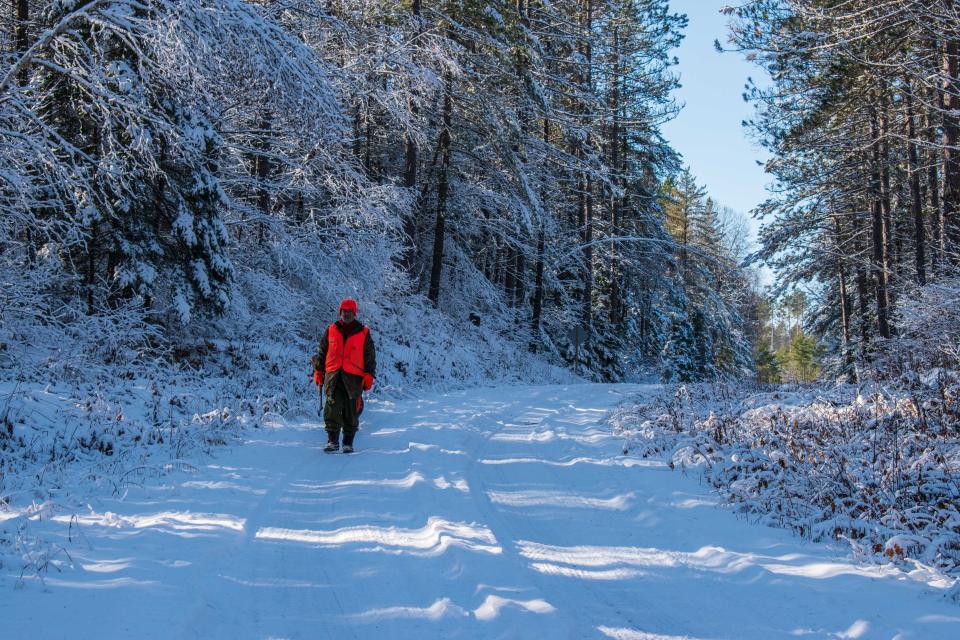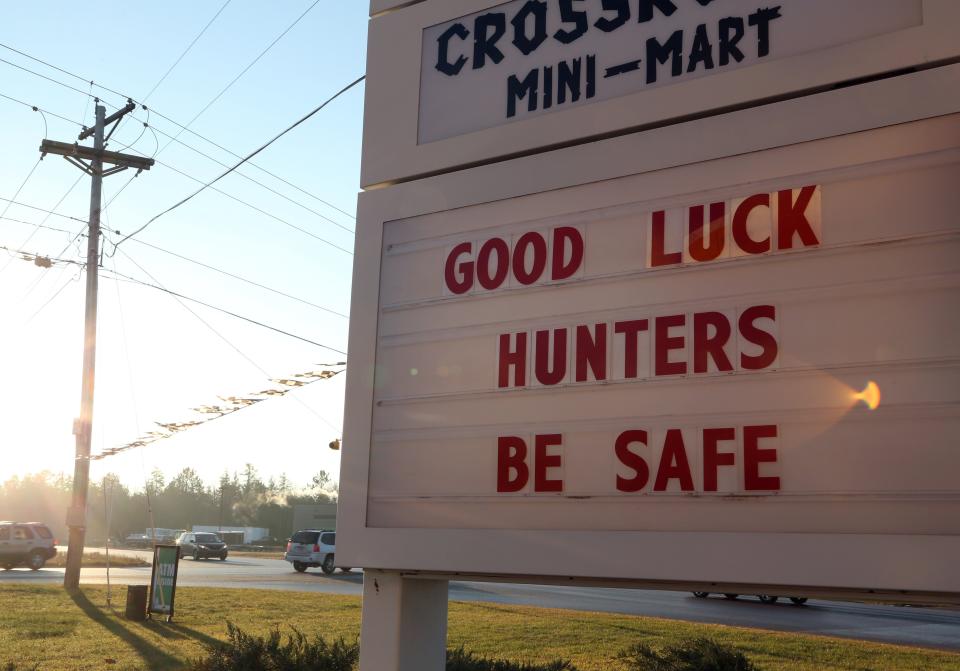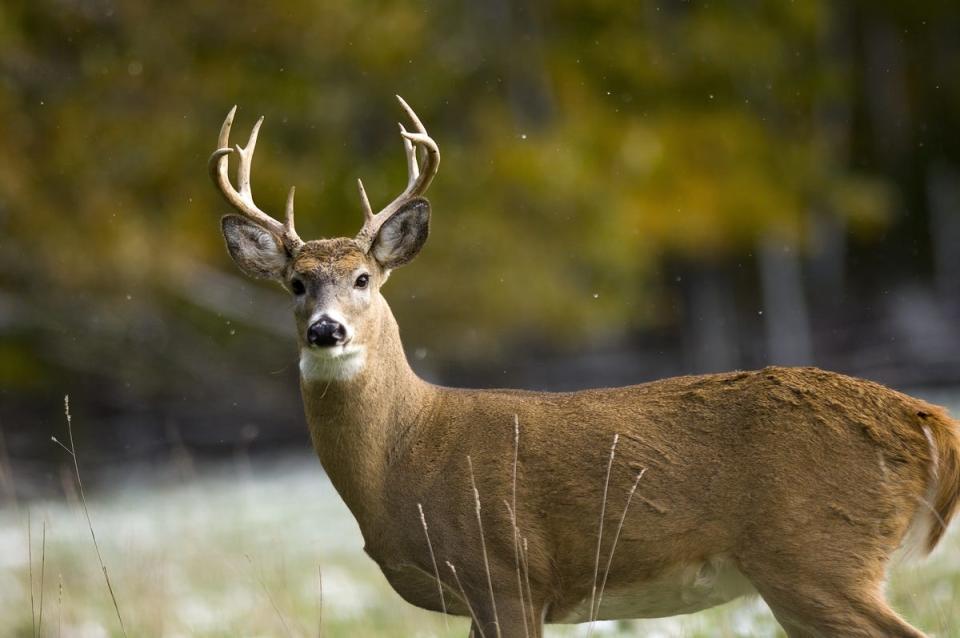Michigan firearm deer hunt numbers plummet, particularly in U.P., and locals blame wolves
Despite selling more deer hunting licenses than the previous year, the 2023 firearm deer season resulted in a significantly lower deer take in Michigan than in 2022 — with the falloff even more pronounced in the Upper Peninsula.
Frustrated U.P. hunters question whether a robust wolf population is depressing deer populations there, but Michigan Department of Natural Resources biologists say the reasons for the decline are more complex.
As of Nov. 30, the reported deer harvest statewide for the 2023 firearm season was at 222,275 deer, down 13% from the 2022 hunting haul, according to numbers prepared by DNR staff for presentation to the state Natural Resources Commission in December.

The hunt was worse the farther north one traveled in Michigan. Though southern Michigan saw a nearly 8% decline in deer harvested season-over-season, the deer take was down almost 18% in the northern Lower Peninsula, and about 28.5% across the U.P.
Why the deer population is dropping in the U.P.
"There's been a deer decline here for 20 years now, really," said George Lindquist, a trustee for 25 years with U.P. Whitetails Association of Marquette County, a nonprofit organization that promotes healthy deer populations and habitat.
Marquette was one of three U.P. counties, along with Gogebic and Ontonagon, that saw deer harvest declines of more than 40% from 2022.
"Up here, the deer have to migrate for the winter, leave the areas where the snow is so deep and go to areas with less snow and shelter," said Lindquist, who is also director for the western U.P. for the Michigan United Conservation Clubs, the largest statewide conservation organization in the nation.
"Losing a lot of our winter habitat has been a key here. Also, our predator load is so high. We have a bad winter, we lose a number of deer, and the wolves will keep the deer down; they won't allow them to come back up."We've got major problems up here that just aren't being addressed."

Jim Kurdziel, field director for the nonprofit conservation organization Whitetails Unlimited's Michigan chapter, noted that the number of deer tags sold in Michigan for the 2023 firearm season was up 2% from the previous year, and the number of hunters buying the tags was up 1% year-over-year.
"When they say the deer harvest is down double digits, they can't assume it's because of a lack of hunters, because (license sales were) up from last year," said Kurdziel, who added he was speaking for himself and not Whitetails Unlimited.
"I believe it's due to the lack of deer numbers throughout the state. Of course, I'm not a biologist; it's just my opinion. I do know over the last couple of years listening to hunters at Whitetails Unlimited banquets, they are seeing less deer than in the past."
That explanation is likely true for at least parts of the Upper Peninsula, said Chad Stewart, deer, elk and moose management specialist for the DNR.
"I think we are very aware that there are places with very low deer numbers in the Upper Peninsula," he said.
Stewart also didn't dismiss the role wolves may be playing.
"Predators, which, obviously, includes wolves, it includes coyotes and, to a lesser extent, bears or bobcats, they are part of the equation that goes into low deer numbers," he said.

Stewart agreed with Lindquist that a loss of places for the deer to ride out sometimes harsh U.P. winters is another large factor.
"A deer has to basically fill its gas tank up going into winter in the Upper Peninsula ... building up as much fat reserves as it can to get through the winter," he said. "What's most important is that they don't burn through that too quickly. And what burns through fat quickly is heavy snowfall for long periods of time. It's hard to move in heavy snow — your muscles get tired, they get burned out, and you burn fat.
"So those wintering complexes are very important. The conifer cover keeps that snowfall from reaching the ground and they can move around a lot easier. We don't have as much of that."
One complication is that about 80% of the type of wintering complexes needed for deer are on private land, Stewart said.
"There is only so much control our agency has in maintaining those complexes," he said. "It really emphasizes the importance of partnership and working with private landowners in those critical areas right now."
Just how many wolves are there in the U.P.?
The DNR last January announced that its annual wolf survey in 2022 showed the Upper Peninsula population holding steady at a minimum number of 631 wolves.
Many Upper Peninsula hunters and residents simply don't buy that number.
"The DNR continues to minimize any conflicts with wolves with the information they put out," Lindquist said. "They are trying to paint a picture that the sportsmen don't believe. Everybody up here knows there are more wolves than they say there are — even the biologists will tell you that."
Lindquist said of the actual wolf count in the U.P., "1,400 is a more realistic number."
DNR staff acknowledge that the estimated minimums calculated during winter surveys are when wolf populations are at their lowest, and prior to the birth of pups. The agency has set out hundreds of trail cameras across the region to assist with future counts, in concert with traditional aerial wolf surveys that occur every other winter.
"We've heard those criticisms and we are looking at alternative methods to try to develop a (wolf population) estimate through different methodology," Stewart said.
Michigan held its controversial first, firearm-only wolf hunt in November and December 2013, with hunters killing 23 wolves in designated areas of the U.P.
Michigan voters then rejected wolf hunting in two statewide ballot measures in November 2014. But the Legislature and Gov. Rick Snyder, at the urging of hunting groups, restored the wolf hunt that year, before a 2014 federal district court ruling again restored Endangered Species Act protections to Great Lakes wolves.
In November 2020 the U.S. Fish and Wildlife Service published a final rule delisting the gray wolf everywhere it was protected in the lower 48 United States. That delisting rule was vacated by the U.S. District Court for the Northern District of California in February 2022. As a result, all gray wolves in the lower 48 United States outside of the Northern Rocky Mountain region are currently protected under the Endangered Species Act.
Multiple parties appealed the district court’s order to the U.S. Court of Appeals for the 9th Circuit. While that action remains pending, Fish and Wildlife Service officials have announced that by Feb. 2 they intend to submit a proposed rule concerning the Endangered Species Act listing status of gray wolves in the lower 48 United States.
"We have lots of wolves," Lindquist said. "We met the criteria to be federally delisted almost 20 years ago.
"We have this wide-open season for coyotes; you can shoot them year-round, day or night. But wolves can't be touched."
A U.P. predator-prey study conducted over nine years, from 2009 to 2019 and including varying winter snow depths, showed a fawn survival rate of 47%. Studies elsewhere in the U.S., both in locations with a presence of wolves and other predators and one location without predators at all, found a fawn survival rate of about 45%.
"Predation from wolves has a relatively small impact on the deer population," DNR officials said.
Nancy Warren, a U.P. resident and director of National Wolfwatcher Coalition, a nonprofit dedicated to the long-term recovery and conservation of wolves, also questioned their impact on the depressed U.P. deer hunt.
"It is far more complicated than making wolves the scapegoat," she said. "Lower Michigan, Maryland, Nebraska and Indiana — all areas without wolves — each saw a decline in deer harvest."
More: Warmer winters, fewer hunters have Michigan deer numbers soaring — and it's becoming a problem
More: Michigan hunting in major decline — why that matters
While wolves alter deer movements, they do not decimate deer populations, Warren said. The relatively stable U.P. wolf populations over a decade or more provide proof of that, she said.
"If there were no deer, there would be no wolves."
A late crop harvest likely behind declines in Lower Peninsula
There is no known wolf presence in Michigan's Lower Peninsula. So why were deer hunt numbers down significantly year-over-year there as well?
A late corn harvest likely played a role, Stewart said.
According to the USDA's National Agricultural Statistics Service, only about 50% of Michigan's corn was harvested by the second week of November, a number that's typically between 66% and 75%, he said.
"It's a product typically of a wet fall," Stewart said. "Farmers can't get into the fields to remove the corn in time."
If deer have abundant corn to eat and standing fields in which to hide, "they are very hard to hunt, and very hard to see," he said.
Upper, lower peninsulas flip deer-hunting script
The reported deer harvest in the Upper Peninsula in the 2023 firearm deer season was around 15,000 deer — a fraction of the peak of about 90,000 deer taken in the U.P. decades ago.
"Going back 60, 70 years, the U.P. was the place to go" to deer hunt, Stewart said. "There were actually very few deer in parts of southern Michigan, to the point where we were actually moving deer around to try to stimulate a population down here and reestablish their numbers."
But an expansion of agricultural activity, particularly corn and soybeans amid the boom in the use of ethanol, caused deer populations to explode in the southern part of the state, Stewart said.
"It's hard to imagine a better plant that is built for a whitetail deer than a soybean plant," he said. "They've got really nutritious foliage early in the summer, and it transforms into this nice little protein packet they are able to get just as that bean matures.
"Combine that with corn and things like waste grain, anything left behind in those fields, the stalks that are left standing, the two are phenomenal for whitetail deer habitat — especially when it's interspersed with the wetlands and the forest matrix that we have throughout much of southern Michigan."
As the deer population explosion happened in southern Michigan, the young forests of the U.P. that allowed deer to thrive there, that grew after the logging boom of the early 1900s, matured. The wolves returned around the 1990s.
"Changing weather patterns, loss of habitat, predation," Stewart said. "When you combine all three together, it starts to create this perfect storm that makes deer recovery really difficult."
But the U.P. deer herd has bounced back from low numbers as recently as the mid-2010s, he said. Stewart believes it will again. A mild start to this winter should help, allowing more deer to survive.
"We are in a unique and new time with deer management," he said. "We've got lower deer numbers and multiple challenges in the Upper Peninsula. And even though we had a lower harvest this year in the Lower Peninsula, we've been trending higher (in deer populations), and we are going to have fewer hunters in Michigan.
"There are a lot of challenges on both land masses ahead of us. It's something we are taking very seriously."
Contact Keith Matheny: kmatheny@freepress.com.
This article originally appeared on Detroit Free Press: Deer hunt harvest numbers plummet in Michigan, most steeply in U.P.

